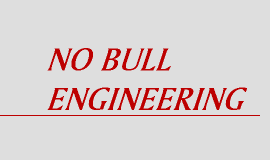TORSIONAL VIBRATION ANALYSIS
OF SYNCHRONOUS
MOTOR-DRIVEN TURBOMACHINERY
by
Mark A. Corbo, P.E.
President & Chief Engineer
No Bull Engineering
and
Clifford P. Cook, P.E.
Texaco Fellow
Texaco, Inc.
Originally presented at:
Texas A&M University Turbomachinery Laboratory
29th Turbomachinery Symposium
September 2000
One of the foremost concerns facing turbomachinery users today is that of torsional vibration. In contrast to lateral rotordynamics problems, torsional failures are especially heinous since the first symptom of a problem is often a broken shaft, gear tooth, or coupling. The difficulty of detecting incipient failures in the field makes the performance of a thorough torsional vibration analysis an essential component of the turbomachinery design process.
The criticality of doing this is heightened whenever the system is driven by a synchronous motor. Synchronous motors are one of the most notorious sources of torsional vibration problems because of the torque pulsations they produce during startups. Since the magnitudes of these pulsations are usually substantial, the resulting shaft stresses are often above the material endurance limits, making the shafts susceptible to fatigue. Accordingly, there is usually a definite limit to the number of startups that a synchronous motor-driven machine can safely be subjected to. It is the aim of this paper to provide users with a practical analytical procedure for predicting this limit.
The paper begins with a brief description of synchronous motors and the mechanisms that make them such a hazard from a torsional vibration standpoint. A step-by-step procedure is then given for calculating the number of starts that such a synchronous motor-driven machine can be safely subjected to. The initial steps, generation of a lumped parameter model, calculation of natural frequencies, and generation of Campbell diagrams, are only given a cursory treatment since they are described in detail in other publications. However, the later steps, performance of the time-transient analysis and, especially, determination of the shaft fatigue lives, are treated in detail.
The authors have observed that most of the existing procedures for doing this utilize the traditional S-N curve and the traditional conservative torsional stress safety factor of 2.0 to predict fatigue life. Although the predicted fatigue life and allowable number of starts are highly sensitive to both of these factors (due to the log-log nature of the S-N curve), use of this method is perfectly fine for the large majority of machines since it errs on the conservative side.
However, in a recent analysis of a well-designed 66,000 hp air compressor train, consisting of a synchronous motor, gearbox, and centrifugal compressor, the authors found the traditional procedure to be too conservative. After performing a considerable amount of research, the authors developed a more sophisticated procedure which, while still remaining conservative, validated the machine’s design. In the new procedure, the traditional S-N curve was replaced with the strain-life theory of failure which has consistently been found to be more accurate than the S-N method. Additionally, the authors found justification for using a safety factor less than the traditional 2.0 value. Furthermore, the authors implemented a rigorous method for accounting for surface finish, size, stress concentration, and notch sensitivity effects as a function of life. This is an area that the authors have observed to be a source of considerable confusion for most engineers. The paper shows the highly sensitive nature of the calculated number of starts depending on the assumptions of various surface finish, size, stress concentration, and notch sensitivity factors. Finally, the mechanics of employing the more sophisticated procedure are illustrated on the 66,000 hp train and its advantages over the traditional method are clearly demonstrated.
ORDER YOUR FREE COPY
BACK
| Home | Why Hire Us? | Services | Principals & Staff | Clients |
| Technical Papers | Short Courses | News Items | Contact Us |

